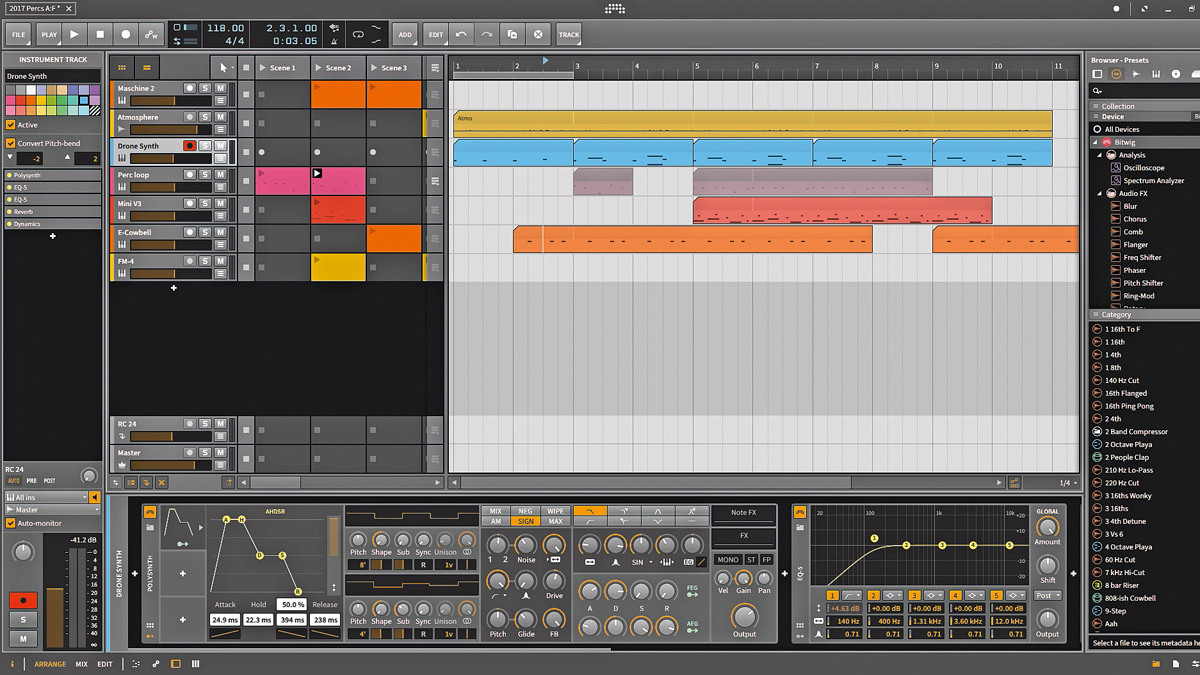MusicRadar Verdict
Bitwig Studio is now a well-rounded and impressive DAW across the board, and the new modulation system is a real cut above.
Pros
- +
Excellent modulation system is hugely powerful and very well-implemented.
- +
New hardware devices make Bitwig an impressive studio hub.
- +
Polysynth is now considerably more interesting.
- +
Plenty of new and revamped devices.
Cons
- -
Multiple toolbars can be a touch fiddly and confusing.
- -
Lacks ‘characterful’ effects and instruments compared to its leading rivals.
MusicRadar's got your back
First released in 2014, Bitwig Studio initially found it difficult to escape the shadow of Ableton Live. Indeed, much of Bitwig’s pre-release hype was built on the fact that it was created by a team largely formed of ex-Ableton developers, and when the newcomer DAW arrived there were a number of interface elements that were clearly inspired by Live.
Still, the persistent comparisons were a little unfair, overshadowing the fact that, from day one, Bitwig was an impressive DAW with a lot to offer in its own right. Several ‘point’ update sover the years have seen it carve out more of a niche for itself, largely by focusing on customisation and flexibility, as well as being one of the first DAWs to fully embrace touchscreen compatibility.
Now version two is here, announcing Bitwig as a more grown-up and fully-rounded DAW worthy of attention on its own terms.
What's new?
At first glance, not a lot has changed in Bitwig’s interface. As before, the workspace is built around an adaptable layout with Arrange, Mix and Edit views, which are joined by Clip Launcher, Device, Browser and Editor panels that can be displayed/ hidden in each view by hitting the relevant tabs.
Version 2 sees changes to the toolbar. Rather than a single set of tools along the top of the UI, the Arrange window and lower Editor panel now have independent sets of tools selected via drop-down menus or your computer’s numerical keys. While there’s obvious flexibility here, allowing users to flip between two editing tasks at once, personally we find having these multiple toolbars a little unnecessary and confusing. We preferred version 1’s single toolbar, although we’re sure plenty of users will disagree. The numerical key switching certainly speeds things up, too.

Bitwig 2 gains a total of 17 new devices. Along with the hardware routing tools, there’s also a suite of fresh MIDI effects. These include tools to control MIDI note length and velocity, a note latch tool, MIDI harmoniser and MIDI echo. There’s also a Multi-Note device, for generating chords from a single incoming MIDI note.
Beyond this, there are five new effect devices, including the previously mentioned Spectrum Analyser. There’s a Phaser, which offers a solid level of frequency and stereo image control. This is joined by a Pitch Shifter, with a range of +/- one octave, plus fine-tune and grain rate controls. Next up is Dual Pan, which offers detailed control of a sound’s placement in the stereo field.
Finally, these are joined by Treemonster, an effect which Bitwig describes as an “organic zero-crossing amplitude controlled ring modulator with a life of its own”. What that exactly means under the hood remains a bit of a mystery, but the resulting device is capable of some inspiring harmonic and inharmonic ring mod effects that respond well to the shape and rhythm of the source sound. It sounds particularly good stuck over drum loops or rhythmic samples to create ready-made Aphex-style squelches and glitch effects.
Elsewhere, the browser has been overhauled, making better use of categories and tagging, which is a noticeable improvement. There’s also a new dashboard view and notification system, both of which make for a slicker and more refined experience.
Beyond these UI changes, the headline feature of version 2 is a revamp of Bitwig’s already-flexible modulation system. The aim here, according to Bitwig, is to move toward a modular device set-up in which instruments and effects can be routed and interlinked with minimal restrictions.
This was, to some extent, already present in version 1’s Unified Modulation System. This system made assigning modulations a simple case of clicking a modulator and dragging the destination to adjust the depth of the effect. It also allowed for the creation of nested device chains in which modulators in one device could be routed to destinations within another in that chain.
This setup has been considerably refined and expanded. The main change is the addition of modulator slots for every device, which take the form of small empty boxes to the left of every Bitwig device or VST plugin. Clicking the ‘+’ in one of these boxes brings up a list of 25 modulators, the output of which can then be routed to any parameter within that device via the same click and drag method.
The device nesting functionality remains, meaning that it’s possible to route one modulator across multiple devices and plugins. It’s possible to route one modulator to another, too, enabling the creation of complex, unpredictable combinations.
As for the modulators themselves, they cover a broad range of bases, including multiple types of LFO, envelope generators, randomisation and routing tools. There is an Expression modulator for routing MIDI note information - such as velocity, timbre and pressure - into devices. There’s also a Sidechain input, enabling any audio signal to act as a modulation source, along with MIDI and CV inputs. There’s a selection of ‘performance’ friendly modulators too, such as assignable X/Y pads, a DJ style Mix tool and the morphing Select-4 modulator.
Beyond the UI changes, the headline feature of version 2 is a revamp of Bitwig’s already-flexible modulation system.
On the whole, these modulation tools are impressively designed and very user friendly. The general LFO, for example, features a simple layout with clear tools for adjusting the wave’s shape, speed, sync options, delay and phase. It does an impressive job of packing a lot of functionality into a few well-laid-out controls.
Every device now has its own Remote Control panel, which features multiple banks of rotaries. These function as a simple way to set up automation and modulation routings, and as a space to create and assign macros, making it easy to create hardware MIDI mappings and so on.
It is, all told, a really excellent system. While the idea of flexible inter-device modulation isn’t new to Bitwig 2, the implementation here is handled exceedingly well. The modulators are very nicely designed, making an exceptionally deep and flexible system feel approachable and user-friendly.
The more you dig into the setup, the more you realise just how capable and creatively inspiring it is. And it comes into its own with Bitwig 2’s other major improvement - deeper hardware integration.
Happy hardware
This comes in the form of a suite of new routing devices designed for sync and control of external MIDI and CV-equipped gear. The existing Hardware Instrument and Hardware FX devices are joined by tools for MIDI CV and MIDI Program Change. There’s a trio of new CV devices, too - a clock output, a simple CV out and a more comprehensive CV Instrument device - that are designed to transmit CV/gate signals via an audio interface.
These devices all feature the same Modulator slots and Remote Controls, which opens up a hugely inspiring range of possibilities for interaction between the DAW and hardware synths and effects. For example, we’d created a number of custom MIDI devices for controlling various bits of MIDI CC-compatible hardware, such as Korg’s Volca FM and Minilogue and the MeeBlip anode. By adding Bitwig’s Modulators to these devices, you can add a whole host of additional envelopes, modulation sources and performance controls that can really expand the sonic remit of your hardware instruments, and makes it a doddle to spice up sounds with organic, fluid modulation. It really is one of the most inspiring approaches we’ve tried in any DAW.

Bitwig’s main synth has undergone a few changes. Firstly, it’s had several of its modulation tools removed, which makes sense as the DAW’s overall modulation system effectively rendered these pointless. The oscillator mix section has been expanded, too, now offering six modes that dictate how the two oscillators interact. This makes it possible to achieve a variety of modulation synthesis effects. There are also controls for creating various audible filter modulation effects.
Polysynth has gained a high-pass filter, feedback loop and improved unison capabilities too - in all a far more interesting synth than the vanilla subtractive instrument we saw with version 1!
There are plenty of other tweaks through the application too. One of the most noticeable is the addition of spectrum analysers. These come in the form of both a dedicated Spectrum device and new dynamic interfaces, which bring visual feedback to Bitwig’s EQ-5, multiband splitter and many other devices. Adjustable fades have been added to audio clips too, for inserting smooth fades and crossfades with a simple click and drag.
Meanwhile, in less visually obvious changes, the DAW now incorporates VST3 compatibility and MIDI Timecode support.
Finally, Bitwig 2 introduces a new semi-subscription-based pricing structure. Purchasing the software entitles users to a year of updates. To get future updates you’ll need to buy an annual update plan for €159 per 12 months. At this stage it’s impossible to say whether this represents good value - that will all depend on the frequency and size of future updates. Either way, you retain full access to the existing software, so there’s no reason not to hold off on shelling-out until Bitwig unveils an update you think warrants the outlay.
There are still a few areas where Bitwig feels less developed than some of its more established rivals. The Compressor and Dynamics devices, for instance, are flexible enough to get the job done, but neither are characterful in the way that, say, Logic Pro X’s can be. Similarly, while Polysynth has been significantly improved for version 2, the selection of built-in instruments remains fairly functional. The Sampler in particular, while capable enough, feels a little lacklustre compared to Logic’s EXS24 or Live’s Simpler/Sampler combo.
Still, these slight weaknesses are understandable in a DAW that’s still in its relative infancy. What’s more, where version 1 felt like it had a few gaps in its toolkit, this time these feel more like areas for future improvement rather than real weaknesses.
On the whole then, Bitwig Studio 2 feels like a fully-rounded, mature DAW that’s capable of holding its own against the market leaders. In terms of creative workflow, however, version 2 is a cut above the competition. The modulation system is hugely inspiring, creative and implemented in a way that makes it accessible. Combine this with the new hardware functionality, along with pre-existing highlights such as the flexible controller API, cross-platform compatibility and flexible effects chains and signal splitters, and Bitwig begins to look like a serious contender.
I'm the Managing Editor of Music Technology at MusicRadar and former Editor-in-Chief of Future Music, Computer Music and Electronic Musician. I've been messing around with music tech in various forms for over two decades. I've also spent the last 10 years forgetting how to play guitar. Find me in the chillout room at raves complaining that it's past my bedtime.

“If it wasn’t for that song, that would have been the end of the band”: How one track’s sudden gear-switch led Coldplay into their imperial phase

“He was like, ‘You’ve got it all wrong, man": Mumford & Sons reveal what Neil Young told them about the way they were approaching their live shows and album recordings

How to write a ‘sticky’ hit: Pure luck can put you in the charts, but sticking around to make the big bucks needs pure science










